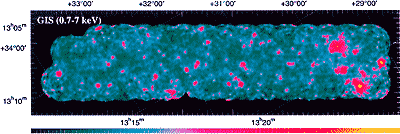
HEA > ASCA > Scientific Results > Cosmic X-Ray Background
If we could see with X-ray eyes, we would be surprised at the brightness of the sky. The presence of intense X-rays coming from the whole sky was discovered at the beginning of X-ray astronomy history more than 30 years ago.

Since they uniformly come from all directions in the sky, they were thought to have a cosmological origin. This X-ray emission was named the Cosmic X-ray Background (CXB). Its origin has been a key issue for X-ray astronomy, but still remains unclear.
Since the spectrum resembles that of a hot plasma with a temperature close to 500 million degrees, an interesting possibility was studied that a hot plasma uniformly fills the universe.
However, little distortion of the Cosmic Microwave Background (CMB) spectrum due to scattering by very hot electrons was detected with the COBE satellite. This has made another implication much more strongly supported: the origin of the CXB is the superposition of faint discrete sources which is unable to be resolved without sufficient observational techniques.
X-ray sky surveys were performed above 2 keV with several X-ray astronomy satellites but only 3% of the CXB was resolved into individual sources in the 2-10 keV band before ASCA.
Furthermore, there is a difficult problem with the origin of the CXB above 2 keV, the so-called spectral paradox : the average 2-10 keV spectrum of the bright sources resolved with the current hard X-ray detectors is significantly softer than the CXB. In the X-ray band, emission is said to be soft when it is dominated by X-rays with relatively long wavelength, and hard when dominated by short wavelength X-rays.
"Soft" and "hard" correspond to "red" and "blue" in the visual light band. The "spectral paradox" of the origin of CXB can be understood by considering an attempt to paint blue with red.
In order to study the nature of hard X-ray sources, and thus provide a clear picture of the composition of the CXB, the first unbiased sky survey above 2 keV (up to 10 keV) with an imaging instrument was performed by ASCA.
The overall ASCA sensitivity spans a wide energy range from 0.5 keV to 10 keV and is higher than any previous mission by two orders of magnitude in the 2-10 keV band.
The survey field is a continuous region near the north galactic pole with a sky area of about 7 square degrees. The hard X-ray sky was resolved into many faint sources for the first time.
Integrated emissions account for 30% of the CXB intensity in this energy range. The average spectrum of the resolved sources is harder than nearby bright sources, and close to that of the CXB. These hard sources are the key to solve the origin of the CXB.
Previous: (2) Identification of particle acceleration sites
Next: (4) Signature of black
hole in our galaxy